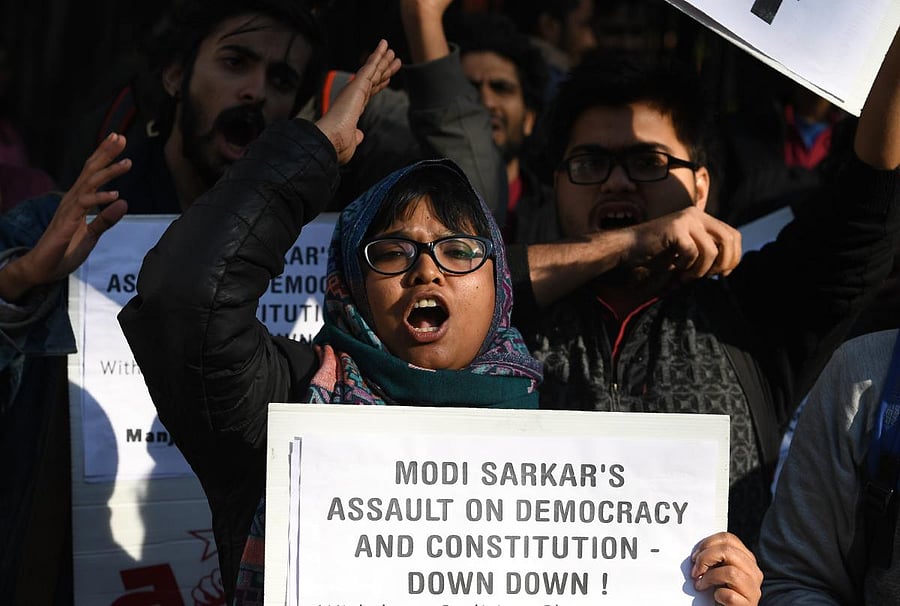The burning issue of the so-called illegal migrants in Assam and some other states in the North-East has assumed disturbing proportions, particularly in the light of the Citizenship (Amendment) Bill, 2016, that has been passed by the Lok Sabha and is awaiting its passage through the Rajya Sabha. The bill signifies the collective contorted thinking of the political system that is piloting it.
It is amazing that the bill allows for “persecuted” Hindu, Sikh, Buddhist, Jain, Parsi and Christian illegal migrants from Afghanistan, Bangladesh and Pakistan to become eligible for Indian citizenship if they arrived in India before December 31, 2014. It is another matter if persecution has occurred at all. Besides, the five communities included in the bill are just a smokescreen to disguise the non-Muslim context. The bill turns out be a not-so-clever camouflage.
What complicates the issue, particularly in Assam, is the 1985 Assam Accord that was reached and signed between three parties — the Government of India, All Assam Students’ Union (AASU) and the All Assam Gana Sangram Parishad (AAGSP) — according to which, only those who had arrived in India before March 25, 1971, were to be considered for Indian citizenship. And the non-Muslim argument of considering Hindu, Sikh, Buddhist, Jain, Parsi and Christian communities for citizenship as is being brought in now through the Citizenship (Amendment) Bill, 2016, did not feature in the Assam Accord. The Accord dealt with any and all immigrant communities, not just non-Muslims.
Of the different arguments proffered for granting citizenship to non-Muslims, one is that there has to be a balance as the Muslim population in Assam is on the rise. Besides, Himanta Biswa Sarma, a cabinet minister of Assam, has gone to
the extent of saying that if the Citizenship (Amendment) Bill, 2016, is not passed, then Assam will go “Jinnah’s way.”
The bill is indeed blatantly lopsided and, in a sense, an arrogant proclamation that amends the Citizenship Act, 1955, to make non-Muslim illegal migrants eligible for Indian citizenship.
The right to equality, guaranteed by Article 14 of the Constitution, lays down that “the State shall not deny to any person equality before the law or the equal protection of the laws within the territory of India”. So, the Citizenship (Amendment) Bill, 2016, is patently a violation of Article 14. Article 14 uses the term “any person”. It is among the fundamental rights that are available to all persons, whether citizens or not.
Assam is clearly in the throes of an excruciating dilemma. On the one hand, it is combating the issue of the National Register of Citizens (NRC), being monitored by the Supreme Court, wherein about 40 lakh people are on the verge of being declared non-citizens or foreigners. And on the other hand, it is concerned with the issue of the Citizenship (Amendment) Bill, 2016, wherein Assam would be forced to accommodate innumerable non-Muslim immigrants who may otherwise be designated as non-citizens or foreigners, going by the NRC.
Interestingly, officially, the State cannot use the term ‘refugees.’ That is a bit of a conundrum as India is not a signatory to the 1951 Geneva Convention on Refugees. Hence, the term refugees can be used only in the sociological or journalistic sense in general. The State cannot use the term as it would be a misnomer in the context of international law.
The human story
In the context of the current situation, it might help us to reflect on the fact that the human story is, in fact, the story of migrations. Would people, in general, be less virulent and maintain their emotional balance if they are made aware of, or learn about, the way humanity has spread over the world only through migrations? Would a lesson on human migrations in history help people if it dawns on them that about 70,000 years ago, except in parts of Africa, the rest of the world was completely unpopulated? And it is only subsequent to what is now known as “Out of Africa” migration that different parts of the world gradually got populated at different times and to different degrees and extents.
All the differences that we see today among humans in terms of height, weight, colour and texture of the hair, colour of the eyes, and overall complexion, in different parts of the world, in what have come to be known as continents, countries, or regions, have come about over just some 2,000 generations.
The small population from a single stock of Homo sapiens that left Africa about 70,000 years back resembled almost exactly the population that we still find around equatorial Africa today. Phenotypically, people in different locales and climes of the world do look so different today due to their existence in the diverse ecological and environmental niches that they have inhabited over centuries, but genetically they are remarkably similar.
All said and done, human history has been, to a great extent, a saga of migrations. So, when someone today refers to or calls another a migrant or an immigrant, it just has to do with time, in the sense that one had arrived relatively earlier than the other.
In a practical sense, everybody has been a sort of migrant historically, and the only people that can claim to be original settlers or the earliest migrants are those who left Africa eons ago and made different parts of the world their habitats and changed outwardly gradually to show all the differences in their appearances as seen today. So, looking at the issue pragmatically, everybody indeed has been a migrant for sure. The squabble that happens today pertaining to migrations is, when looked at with reason, balance and logic, utterly misplaced.
(The writer is Dean – Administration and Regulatory Affairs, Krea University, Sri City, Andhra Pradesh)
(The Billion Press)
